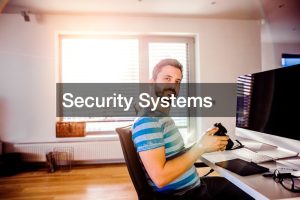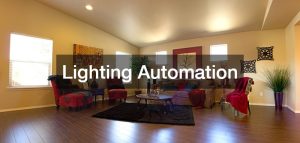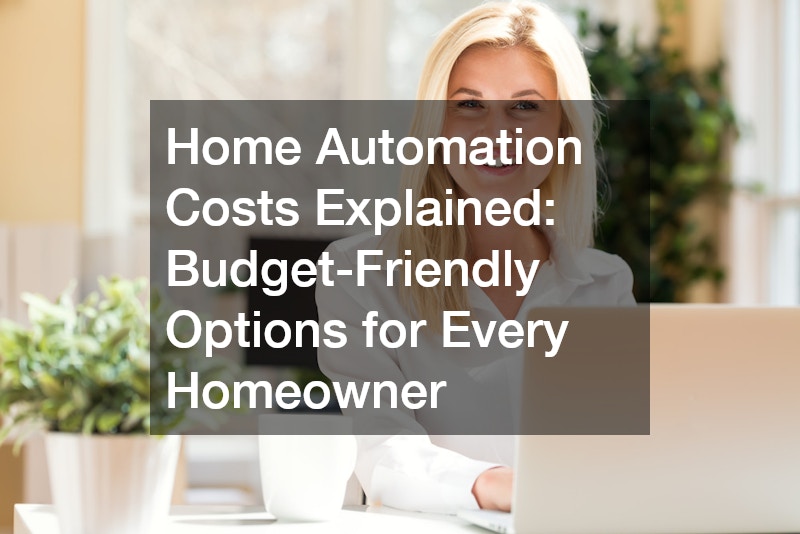Home Automation Costs Explained: Budget-Friendly Options for Every Homeowner
- Home automation allows homeowners to control systems like lighting, security, and energy efficiency with smart devices.
- Costs range from $15 for basic devices to $4,500 for fully integrated home systems.
- Benefits include energy savings, improved security, and convenient control via apps or voice commands.
- Budget-friendly options, like smart plugs and DIY installations, help homeowners begin automation without high costs.
- Key home automation devices include smart thermostats, security cameras, and lighting solutions.
- Homeowners can start small and gradually expand their automation systems as needed.
- Smart systems offer long-term cost savings and increased property value.
- The right mix of automation can enhance convenience, efficiency, and security without breaking the bank.
Introduction
Home automation continues to revolutionize how we live, bringing unparalleled convenience, energy efficiency, and enhanced security to homeowners worldwide. These smart systems promise easier control over various aspects of your home, from lighting to entertainment, often remotely and via automated processes.
Understanding how much does home automation cost is crucial for homeowners considering incorporating smart technology into their living spaces. This article will delve into various systems, their associated costs, and budget-friendly options available to everyone.
In this comprehensive guide, we’ll explore different types of home automation systems, their costs, and how you can enjoy their benefits without breaking the bank. We’ll discuss various options that fit into any budget and show you how to maximize the value of these systems.
What is Home Automation?
Definition and Components
Home automation employs technology to control household systems and appliances autonomously or remotely. This increasingly popular concept involves components like smart thermostats, lighting, security systems, and entertainment devices, all of which can be interconnected for seamless operation.
The core components of home automation systems include various sensors and devices, such as smart lights and cameras, that communicate over a network. These components execute tasks based on user inputs or pre-set programs, enhancing the efficiency and convenience of managing a home.
Understanding how much does home automation cost involves knowing these elements’ costs. Each component contributes to the overall investment required, with variances depending on personalization, brand, and the extent of automation.
Key Benefits of Home Automation
One of the most significant benefits of investing in home automation is energy savings. With smart thermostats capable of efficiently managing heating and cooling, homeowners can save up to 10-15% on energy annually, significantly reducing utility expenses over time.
Enhanced security is another fundamental benefit, as video doorbells, smart locks, and surveillance cameras provide increased peace of mind. These devices offer real-time monitoring and notifications, helping deter potential intrusions and ensuring home security.
Additionally, home automation boosts convenience and lifestyle enhancement by allowing control over various parts of your home through voice commands or smartphone apps. This hands-off approach to managing home activities aligns with busy modern lifestyles.
Breakdown of Home Automation Costs
Average Costs in the U.S.
Understanding how much does home automation cost in different setups is pivotal for budget-conscious homeowners. In the U.S., the price for a comprehensive, fully integrated home automation system typically ranges from $1,500 to $4,500. However, simple setups may start with individual devices costing as little as $50.
While the high-end spectrum provides a more luxurious and integrated experience, lower-cost options offer basic functionalities that are perfect for those starting their home automation journey. Starting small allows incremental upgrades based on one’s lifestyle needs and budget.
Affordable entry points into automation include smart plugs and basic sensors, accessible to many homeowners. As you plan your automation system, consider both your immediate needs and potential expansion in the future.
Factors Affecting Costs
How much does home automation cost is influenced heavily by the scope of automation desired. Equipping an entire home with high-end systems will naturally cost more than automating a single room or selecting basic devices for essential functions.
Another significant factor is the choice between professional installation and DIY setups. Professionals might ensure more seamless integration and setup but at a higher labor cost. Alternatively, many devices are designed for straightforward DIY installation, reducing overall expenses.
Additionally, monthly subscriptions required for advanced systems or to access premium features of certain devices also play a role in the overall cost. It’s crucial to weigh these ongoing expenses when planning your budget for home automation.
Types of Home Automation Systems and Their Costs
Security Systems

Security systems are a primary component of home automation, with costs ranging from $200 to $1,500, depending on the complexity and devices selected. Smart locks, cameras, and motion detectors are integral security components that provide reliable monitoring and alerts.
Investing in these systems enhances the safety of your home while offering remote control and real-time monitoring features. This added security layer can also reduce homeowner insurance premiums, offering additional financial benefits.
As homeowners evaluate how much does home automation cost, incorporating security system investments should be prioritized given the crucial peace of mind they provide.
Energy Efficiency Systems
Energy efficiency ranks high on the list of automation benefits. The cost of devices like smart thermostats generally falls between $120 and $250. They provide substantial savings by optimizing heating and cooling schedules, adjusting settings based on user preferences, and offering energy usage insights.
These savings accrue over time, with some homeowners recouping their initial investment within a few years. Devices like smart plugs and light dimmers further contribute to lowering energy consumption, a critical factor in addressing how much does home automation cost in the long term.
Combined with energy-efficient lighting and appliances, automated systems can lead to significant reductions in annual utility bills, making them a wise investment for future savings.
Lighting Automation

Smart lighting systems offer convenience and cost savings, with investments starting at $10 for individual bulbs and up to $100 for smart switches. These systems allow homeowners to program schedules and control lights remotely, enhancing convenience and security during vacations or late hours.
Through mobile apps or voice commands, users can adjust light settings, reduce energy consumption, and create ambiance to suit various moods or activities. This not only optimizes electricity use but also enriches home experiences.
The affordability of smart lighting solutions makes them an attractive entry point for those exploring how much does home automation cost without incurring significant expenses.
Entertainment Systems

Smart entertainment systems vary widely in cost, ranging from $300 for basic smart speakers to $1,500 for complete home theater setups. Integrating these systems allows seamless control over video and audio devices, offering personalized entertainment experiences.
The choice of equipment, including smart TVs and streaming systems, depends on personal preferences and budget. Many of these devices interoperate with voice assistants for hands-free content browsing and control, boosting their appeal.
As part of the broader automation ecosystem, entertainment systems can connect with other smart devices to create integrated experiences that exemplify the ultimate modern convenience.
All-in-One Systems
All-in-one systems present a holistic approach to home automation, with packages like Google Nest, Amazon Alexa, or Apple HomeKit offering integrated solutions. The costs for these comprehensive setups typically range from $1,000 to $5,000, providing centralized control over all connected devices.
This type of setup appeals to those seeking a unified interface and seamless device integration across various categories, from lighting to security and climate control.
Though the initial investment might seem higher, the consolidated control and enhanced efficiency such systems provide are highly valued. They offer a robust answer to how much does home automation cost by fulfilling multiple user needs in a single platform.
Budget-Friendly Home Automation Options
Affordable Devices for Starters
For homeowners wondering how much does home automation cost and seeking budget-friendly options, starting with affordable devices like smart plugs or entry-level smart speakers is advisable. These devices, priced between $15 and $30, can be integrated into home systems without significant financial strain.
Smart plugs allow users to automate on/off schedules for any connected appliance, providing initial exposure to the benefits of automation. Likewise, devices like the Amazon Echo Dot or Google Nest Mini offer voice control capabilities at minimal cost.
By beginning with these small investments, homeowners can gradually expand their systems as they become more familiar with the technology and experience its benefits first-hand.
DIY Installation Tips
One effective way to reduce how much does home automation cost is to opt for DIY installations. Many devices are designed with user-friendly installation processes, enabling homeowners to set up their systems with minimal professional help.
Devices like smart thermostats and cameras come with comprehensive guides and mobile apps to assist with installation and configuration, reducing labor costs significantly. Many online tutorials further aid in simplifying the setup process.
By tackling installations personally, homeowners can allocate their budget towards purchasing higher quality devices rather than paying for professional services, gaining considerable savings in the process.
Platforms to Save Money
Homeowners can address how much does home automation cost by opting for platforms that do not require mandatory subscriptions. Many systems operate on free or low-cost apps that provide the necessary control features without burdensome recurring costs.
Platforms that operate seamlessly across various devices allow users to avoid subscription fees, making long-term automation more sustainable, especially for complex systems involving numerous gadgets.
Moreover, leveraging free ecosystems and applications can ease the financial aspect of home automation, enabling broader adoption and integration of smart technologies at home.
Maximizing Value with Home Automation
Energy Savings to Offset Costs
Maximizing value from home automation often involves focusing on energy savings to offset the initial investment. Smart thermostats and lighting systems can significantly reduce energy bills, demonstrating the long-term advantages of automation.
Statistics show sizeable cost reductions through optimized energy usage, reinforcing the importance of smart devices in financial planning. These savings add substantial value and make understanding how much does home automation cost a worthwhile endeavor.
Over time, the accumulated savings on utilities can financially justify the initial expenses of automation systems, driving their adoption among budget-minded homeowners.
Enhancing Home Security on a Budget
Improving home security need not be costly, as basic devices like smart cameras or alarms can deter potential intrusions effectively. Simple interventions can dramatically enhance residential safety, proving that effective security systems can be installed on a budget.
Moreover, these devices can be monitored remotely, providing homeowners superior situational awareness of their property. With security upgrades, how much does home automation cost can be balanced against the invaluable peace of mind gained.
This gradual, budget-conscious approach ensures comprehensive security coverage without significant upfront investments, maintaining financial prudence while protecting home assets.
Smart Upgrades for Resale Value
Investing in smart home technology can enhance a property’s resale value, adding modern appeal for potential buyers. Automation systems are increasingly sought after, contributing positively to real estate evaluations as they offer convenient, future-proof living environments.
By integrating automation solutions, homeowners can achieve a competitive advantage in the real estate market, where tech-savvy buyers value homes equipped with state-of-the-art technology.
Smart upgrades not only tackle how much does home automation cost but also strategically improve property value, making them a wise financial decision in terms of both personal benefit and eventual asset appreciation.
FAQs
- How much does it cost to fully automate a home in the U.S.?
Fully automating a home can range from $1,500 to $4,500, depending on the devices and systems chosen. - Can I integrate home automation into an older house?
Yes, most smart home devices are wireless and can be easily installed in older homes without significant modifications. - What is the lifespan of home automation devices?
Most smart home devices last 5-10 years, depending on the brand, usage, and maintenance. - Are there energy savings from using home automation systems?
Absolutely. Systems like smart thermostats and energy-efficient lights can reduce energy bills by up to 15%. - What happens if the Wi-Fi goes down?
Many smart devices have local controls or backup systems to ensure limited functionality during outages.
People Also Ask (PAA)
- What are the most affordable smart home devices for beginners?
Smart plugs, basic motion sensors, and entry-level smart speakers like the Amazon Echo Dot are excellent starters. - How do smart thermostats save money?
They optimize heating and cooling schedules, adjust settings automatically, and provide energy usage insights to reduce waste. - Are there any hidden costs with home automation?
Possible hidden costs include subscription fees for certain services, device upgrades, or increased electricity usage for some systems. - Which smart home brands offer the best value for money?
Popular budget-friendly brands include Wyze, TP-Link, and Amazon Basics for cost-effective yet reliable devices. - How do I ensure compatibility between different smart home devices?
Use devices within the same ecosystem (e.g., Google Nest, Amazon Alexa) or choose systems that support multiple platforms.
Resources and References
- Statista: Data on home automation adoption trends and costs.
- Energy Star: Insights on energy savings using smart devices like thermostats.
- Google Nest Official Site: Specifications and pricing of smart home devices from Google Nest.
- Amazon Alexa Official Site: Information on affordable smart home devices from Amazon Alexa.
- CNET Smart Home Guide: Comprehensive reviews and guides on various smart home systems.
Conclusion
In conclusion, understanding how much does home automation cost involves a thorough examination of available systems, their benefits, and budget-friendly options. Exploring the various factors affecting pricing helps homeowners make informed decisions based on their specific needs and budgets.
By starting small with affordable devices and utilizing DIY installation methods, anyone can enjoy the benefits of smart technology. Advancements in these systems are not only making homes safer and more energy-efficient but also more attractive to potential buyers.
Incorporating budget-friendly home automation allows you to experience the future of living—incrementally scaling up solutions to match your lifestyle and budget. Homeowners can embark on this transformative journey, confident that their investment in home automation is worthwhile.
